Not surprisingly, chickens get chicken pox too. Except in their case, it’s called fowl pox and like the human version, it’s a contagious viral disease with no cure and no treatment, other than trying to keep morale up.
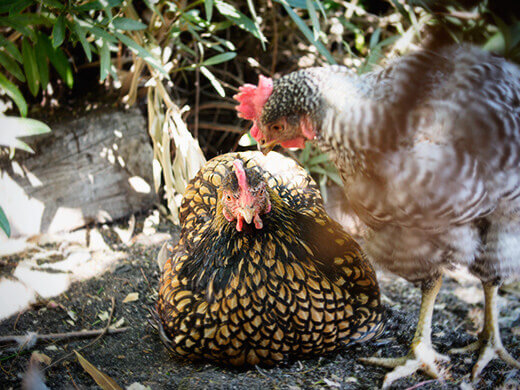
Both of my chickens are in the middle of their molts, so I didn’t think too much of it when they started foraging less, playing less, and laying less (until the eggs ceased completely two weeks ago).
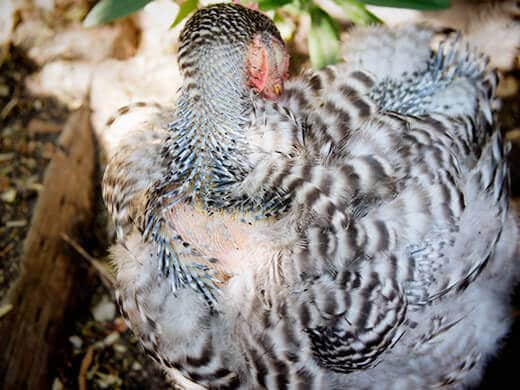
A molt takes a lot out of a chicken and my poor Kimora is going through a pretty rough patch this year. She’s dropping feathers much more heavily than she did last year, and the only thing that will get her to run and jump is a handful of dried mealworms (which I’ve been giving more often, as well as black oil sunflower seeds and scrambled eggs). Otherwise, she spends the day lounging in the sun, partaking in the occasional dust bath, waiting for me to bring more treats. She is not a happy camper right now.
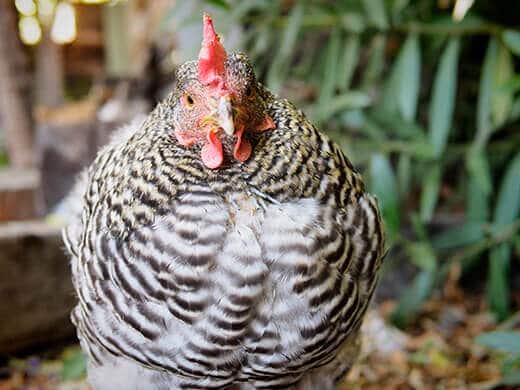
A couple weeks ago, I noticed little black bumps of what looked like dried-up blood on her comb and dismissed them as battle wounds from possible pecking. She was quiet and lethargic, but I attributed it to a very hard molt. She had also stopped laying, which didn’t seem unusual considering the season, though last year she would still lay an egg or two a week through the dark days of winter.
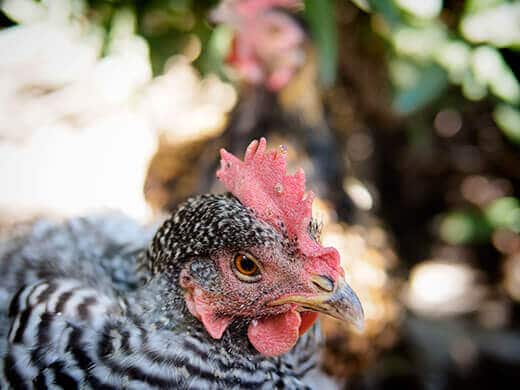
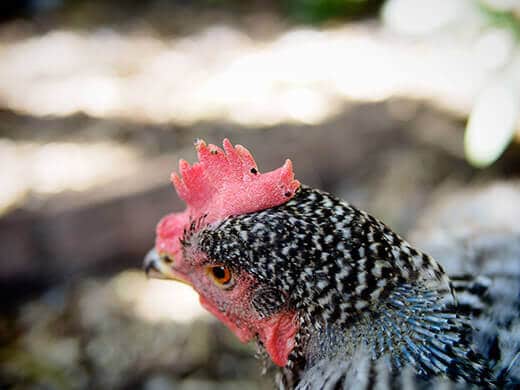
I noticed her scabs were starting to heal last week, becoming less prominent, and she seemed to regain her energy a bit. But… I also noticed that Iman was getting those same bumps on her comb! The warty-looking nodules started appearing around the same time Kimora’s were clearing.
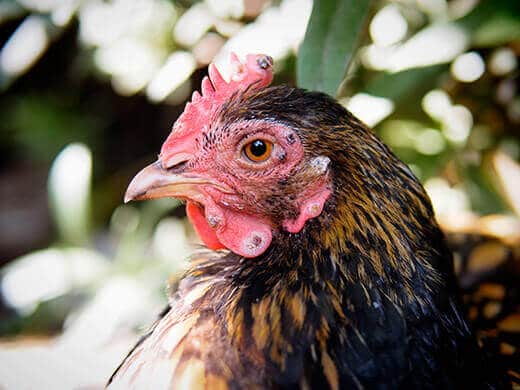
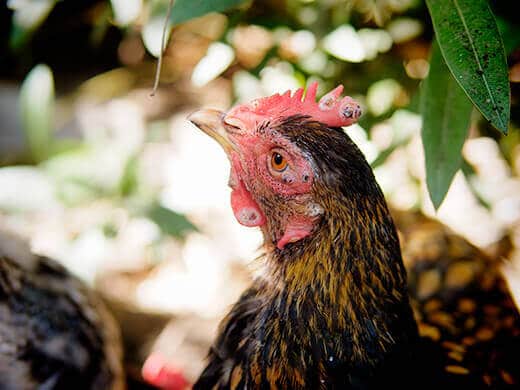
Unfortunately for Iman, her case of fowl pox seems much more intense. In a span of just three days, the bumps had multiplied and become larger in size. The first ones are starting to crust and scab over, leaving black bumps on her comb, wattle, ear, and face. She’s moodier and lazier, though she’ll still skip up to me when she hears the “special door” on the coop opening… you know, the door where yummy treats magically fall out.
Aside from the heavy molting and scabby pox (poor girls just can’t catch a break this season!), both chickens seem to be in decent health and average spirits… as much as a couple of sick chickens can be healthy and spirited, that is.
Fowl pox runs its course in two to four weeks and the best treatment is to let it do its thing. You can dab some iodine on the lesions to make them dry up faster, but I’ve found that they scab pretty readily. Once the fowl pox has fully cleared, infected birds get partial immunity from the same viral strain (just like humans do). They usually won’t get fowl pox again, but if they do, subsequent cases are likely to be less severe.
My only worry is secondary infection, when lesions appear inside the mouth and the respiratory tract, affecting the esophagus, pharynx, larynx, and trachea. This type of infection is called wet pox, or diphtheritic fowl pox. Advanced wet pox can interfere with feeding or breathing as the lesions become enlarged, blocking the airways.
My chickens have dry pox, or cutaneous fowl pox. These round, raised lesions (usually with dark scabby centers) only appear on areas of the body with no feathers, generally the comb, wattle, face, or feet. Dry pox is a nuisance, but rarely fatal. Neither forms of fowl pox are contagious to humans or other animals.
The virus is transmitted by mosquitoes, but can sometimes pass from bird to bird by mites or lice. Once a chicken is bitten by a mosquito carrying the virus, it’s almost certain that the rest of the flock will be infected as well. This usually happens if a mosquito continues to bite the other chickens, or if the infected chicken drinks from a water fountain and backwashes the virus into it. Other chickens then pick up the virus by drinking from the same water.
Infected chickens also drop infected feces, so the virus can enter a food or water source that’s been contaminated by droppings. This includes the droppings from pigeons, sparrows, and other wild birds that may be infected, as they all carry related strains of the pox virus.
Fowl pox virus can survive in the environment for at least a year (through dander or dried scabs that have fallen off). It’s a resistant and slow-moving virus, infecting an entire flock over a period of a month or more. Just as you think your chickens are getting well, others start to show symptoms. They’ll slow or stop their egg laying, become lethargic, probably eat less… but they’ll always have those telltale warty bumps.
While there’s no real treatment for fowl pox, you can try to prevent reinfection by cleaning and changing out the water supply every day; removing and replacing the bedding; disinfecting nests, roosts, and other places where your chickens spend a lot of time; and generally keeping the surroundings neat and sanitary. Eliminate any standing water, and pay special attention after a rain for puddles that mosquitoes might be breeding in.
I always add a little food-grade diatomaceous earth to the sand in their run (raking it in evenly), as well as dust the nests and pine shavings with it. Diatomaceous earth (also known simply as DE) controls mites and lice by drying out their exoskeletons as they scratch their way through the fine powder (made from the crushed-up fossils of hard-shelled algae).
DE is a cheap and easy preventative measure that any chicken-keeper should take, even without signs of infestation. Make sure you use food-grade DE — usually found in garden nurseries or feed stores — and not the DE intended for swimming pools.
Prevention of fowl pox comes in the form of a live virus vaccine. You can ask an avian vet for it, or purchase the vaccine from a poultry supplier and administer it yourself. Only healthy birds should be vaccinated, and birds that have already gone through fowl pox will not need the vaccination as they’ll develop immunity from it. The Merck Veterinary Manual offers more information about fowl pox (which also affects turkeys).
As for my girls, Kimora seems to be healing well and I hope she’ll recover fully in another week or so (and maybe even start laying again… fingers crossed). Iman might have another couple weeks to go with her dry pox, but so far the lesions don’t seem to be bothering her, despite one being very close to her eye.
I’m not doing anything out of the ordinary for them, other than keeping them comfortable through their molts and upping their protein intake. (Find out how to help your chickens grow back beautiful feathers before the cold sets in.)
Oh, chickens… always keeping me on my toes, that’s for sure.
















One minute you are saying it will only infect chickens… Not humans or any other animals. Then you’re saying that chickens catch it from infected mosquitoes… must be those little mechanical mosquitoes. Or they might catch it from the droppings of infected pigeons or sparrows… And then you wrap it up by saying that turkeys can get it. Very informative article. I learned so many unbelievable things that are truly and literally incredible.
Not sure where you misunderstood the article. Fowl pox virus is transmitted by infected mosquitoes to birds including chickens. (There are different strains of fowl pox, not all of them are contagious to chickens.) You cannot catch fowl pox from your chickens, and neither can your animals (such as dogs and cats).
I want to ask whether u can give the hen the attenuated vaccine instead of live vaccine to increase the immnune response since the attenuated one cannot cause disease
Please consult with an avian vet.
Hi Betty: Thanks so much for the great information & the closeups of your hens with the pox. I will know what to look for should this happen to our 6 hens. We live in Central America and get good mash for the hens, all layers. 4RR; 2 bigger hens-one is all white & the other has black striped feathers around her neck, tufts on the side of her face, does not like to fly, has taken over the “boss” of the coop. No roos. We had a beautiful multicolored hen with a comb that draped down over her beak & I could never figure it out. I gave her back to our chicken guy because all she wanted to do was to brood. She laid light green eggs. She wanted to be a mother & would hoard the nexting boxes.
Can the mash be fermented? I used to do this & quit as it seemed to be a headache. The mash they are eating a lot of it. It is supposed to be balanced. I also give them banana leaves, comfrey leaves, homemade raw milk cottage cheese, broadcast wheat seeds/millet maybe once a wk/2. I use DE under their roosting rods once a month or so. They are doing well. We get about 3-4 eggs/day. Right now is the rainy/winter season so they have slowed a bit. I also give them ground up egg shells but put it in their mash as they won’t eat it otherwise. But I also see evidence of it on the ground.
Thank you so much for the info & great closeup pics.
Yes, you can definitely ferment the mash but since it will turn quite liquidy, it might result in more waste if the chickens can’t/don’t pick it all up.
I always love your posts! The most informative chicken blog I’ve found! QI’ve been told that vaccinating infected birds can speed their recovery, but I’m not sure of the truth of that. Here you say only healthy birds should be vaccinated. I was wondering if you have more info about this! My flock are all showing signs of dry pox, but all but two only have really tiny black specks on their combs. Two have full blown lesions like you’ve pictured here. I don’t know if it’s worth vaccinating them or not.
Thank you Emilie! And to answer your question, no you should not vaccinate your birds if they already have fowl pox. The pox vaccine is a live virus, so you would actually be injecting more virus into them. The vaccine causes a mild form of the disease, which is why it’s only recommended for healthy birds whose systems can fight it off. (The reason you vaccinate healthy birds is to give them immunity from it later.)
Our kind of chicken pox doesn’t actually come from chickens. But they do get it: The Real Chicken Pox http://t.co/ffW5D3h9p7 #poultry
Great blog! I must have read 10 posts trying to see if my birds would keep getting it. Thanks so much. Now I won’t worry! Each of my 3 chickens have only 2-3 bumps on their comb so not too bad. I shared this in a Facebook chicken group I belong to also. Thanks again!
You’re welcome, and I hope your ladies heal soon!
I had NO IDEA. That’s great that your girls got through it okay but I wonder if it had to do with your constant care or if hens normally have a high survival rate?
They are actually still going through it. Kimora’s pox is nearly healed, but Iman’s is still quite scabby. With only two hens, the virus should run its course in the same month. I think a larger flock would be more difficult to monitor and prevent reinfection; I’ve read that fowl pox can exist in a flock for months as it affects different hens in cycles.
Control mosquito infestations near your chicken coop to prevent infection: The Real Chicken Pox http://t.co/yriGjwCqBR #homesteading
Rarely fatal, but a nuisance all the same – and it spreads from mosquito to chicken. The Real Chicken Pox http://t.co/fTd5PoEuyE #poultry
Tracy Thatcher liked this on Facebook.
Matti Salomaki liked this on Facebook.
RT @theGardenBetty: Oh, chickens. Always keeping me on my toes. The latest affliction in the coop: The Real Chicken Pox http://t.co/3qRx5Ic…
Oh, chickens. Always keeping me on my toes. The latest affliction in the coop: The Real Chicken Pox http://t.co/3qRx5Icrhy #homesteading
Yes, chickens get chicken pox too. And it’s just as annoying as the human version. The Real Chicken Pox http://t.co/VwvHkyZI62 #poultry
The Horticult liked this on Facebook.
Hillary Kenney liked this on Facebook.
I hv bn learning so much thru ur blog. Hope ur two girls get better soon.
Thanks Candace!
The Real Chicken Pox:
Not surprisingly, chickens get chicken pox too. Except in their case, it’s called fowl … http://t.co/7KC7jVqyOt
Blogged on Garden Betty: The Real Chicken Pox http://t.co/QKkJEGwdZ1